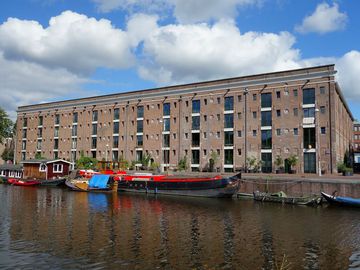

The Municipal Energy Company was a utility company that generated and distributed electricity throughout the city. The company was established in 1941 after the merger of the Municipal Electricity Works (GEW), and the Municipal Gasworks, both established in the end of 20th century. In addition to the municipal network of gas and electricity distribution, the GEB had its own power plants in the north and west side of the city. In 1985, partially due to new European regulation as well as the rising competition, the GEB was disbanded and privatized. The empty building was soon taken over by squatters, most of whom were artists. Squatting, an important movement in the citys life during those decades was quite common in Amsterdam throughout the 1960s-1990s.
Compared to the nearby Entrepotdok housing complex, which was meant to be rent-controlled and affordable to the middle class, once gentrification arrived in the late 1990s, the former GEB was turned into luxury residencies. After the completion of this massive housing reconstruction project in a prime city location, the warehouses of the former Municipal Energy Company (GEB) site between the Entrepotdoksluis and Geschutswerf were converted into unsubsidized condominiums in the private sector. This Kalenderpanden (literally Calendar Houses) are named after the months of the year. The properties were initially taken over by squatters, but the municipality cut off water and managed to clear these premises in 2000. Architect Claus en Kaan developed 42 apartments in 12 different houses. An average apartment in this housing project costs over 1 mln euros. This project is one of the striking examples of gentrification in Amsterdam, whereby industrial areas were converted into luxury high end living premises.
Built in 1903, the former Amsterdam Energy power plant, also known as Machinegebouw (Machine Building), Centre Energetica fulfilled the function of a museum of energy. The museums collection included items on energy production as well how gas and electricity, to this day the two main sources of energy in Amsterdam, were employed by the city. The funding was cut and, in 2008, the collection was acquired by the NEMO Center.
The east half of the building facing Hoogtekadijk was built in 1903 according to a design provided by the Department of Public Works, and was one of the first power stations in Amsterdam. The Berlin firm named Allgemeine Elektrizitäts Gesellschaft (AEG) installed the actual electric equipment, which in its time provided electricity for the trams and for the cranes in the harbor. Via the Eastern Docklands, ships carried the coal by which the plant was heated. Starting in the 1950s, there was a 150 kilovolt high-voltage substation housed here, providing 60% of the city center with power. When the demand for electricity rose rapidly, an identical part was built in 1908 on its western flank. In 2002, the building became a national monument and, since 2002, a part of the Netherlands industrial heritage.
The collection of the Energetica, now located at the NEMO, included large artifacts, such as electrical transformers, generators, motors and lifts, as well as smaller household appliances such as various types of washing machines, refrigerators, radios, televisions, VCRs, gas appliances and lamps. During its existence, Energetica received 10,000 visitors annually. It sought to increase its number of visitors by modernizing the property. At this point the building is occupied by some businesses and residence.